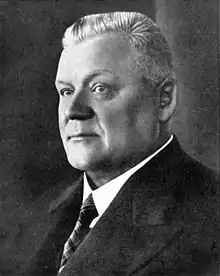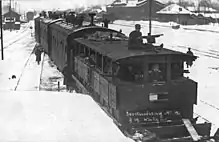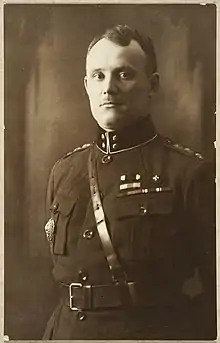Walk crisis
The Walk Crisis (also called the Valga Crisis or the Valka Crisis, after the Estonian and Latvian names of the town respectively) was an episode in Estonia–Latvia relations over the territorial disputes along the borders of the two countries, chiefly about the town of Walk (now Valga, Estonia and Valka, Latvia) and the island of Runö (now Ruhnu, Estonia). The territorial disputes lasted from both countries' independence in 1918 until its settlement in a border agreement in October 1920, culminating in the spring of 1920, when war between the two nascent republics almost became a possibility.
| Walk Crisis | |||||||
|---|---|---|---|---|---|---|---|
| Part of Estonian War of Independence and Latvian War of Independence | |||||||
_(1904).jpg.webp) Map of Walk County, 1904 | |||||||
| |||||||
| Belligerents | |||||||
|
|
| ||||||
| Commanders and leaders | |||||||
|
|
| ||||||
Background

During the War of Independence, Estonians were stronger militarily and immediately took advantage of this in their relations with Latvia. When the Red Army in Riga and Latvian hunters fell in January 1919, the Latvian Provisional Government fled to Liepāja. Allied forces were asked to help save the situation. The Prime Minister of Latvia, Kārlis Ulmanis, also sent a request for assistance to the Estonian Provisional Government. Estonians agreed to help, but for a fee. On February 18, 1919, an agreement on relations and joint military activities was signed, which gave the city of Walk and seven border rural municipalities to Estonia until the state border was determined.
By the summer of the same year, the whole of Northern Latvia was liberated by joint force, but in October the situation became critical once again. Namely, on October 8, a German-Russian force based in Courland, led by Russian Major General Pavel Bermondt-Avalov, launched an offensive in Riga. The aim of the attack was to overthrow the Latvian government. "A serious German-Russian attack has begun, we are asking for help immediately!" A telegram arrived from the Latvian government. "Send two armored trains to Riga without delay," Estonian Commander General Johan Laidoner telegraphed to the commander of the armored train division. Armored trains, along with paratroopers, rushed to Latvia and Bermondt-Avalov's troops were smashed.
Estonia and Latvia started negotiations on a new military agreement on October 10, 1919, as the February agreement had been revoked by the Latvians as an unauthorized agreement. During the negotiations, the question of Walk came up again. The Latvians did not agree with the Estonian proposal, after which Laidoner ordered the armored trains to be brought out of Riga.[1]
Walk had historically almost always been dominated by ethnic Estonians, although ethnic Latvians constituted a plurality of registered voters.[2]
Escalation
Relations between the two neighbors continued to heat up. By the end of 1919, the Latvian Ministry of Foreign Affairs was forced to admit that their great concessions would not find any return on the part of Estonia. However, seeing that the negotiations were not going anywhere, the Estonians decided to use force. On Christmas Eve, 1919, General Laidoner ordered the Latvians to end the work of their civilian institutions both in Walk and elsewhere in the occupied territories of the Estonian army. They were threatened with being sent across the border if they refused to comply with the order. The Latvians did not intend to comply with Laidoner's order, and the situation was getting worse. In January 1920, the leaders of both countries met, but no agreement was reached.
The leadership of the Estonian army, especially Laidoner and his chief of staff Reek, had a very good opinion of themselves, and this arrogance only increased over the years; their attitude towards Latvia was characterized by undisguised snobbery, in many cases even with mixed contempt, especially when it came to Jānis Balodis, who did not take part in the Battle of Võnnu and was despised by Estonians for their lack of will and cooperation with the Germans. The following meetings between Estonians and Latvians did not bring a breakthrough either as the Estonians did not want to hear about the division of Walk. At the end of February, Latvians made the last attempt to compromise: Walk was to become a free city. Estonians rejected the proposal.
By the beginning of March 1920, Estonia and Latvia were on the verge of war. On the evening of March 10, a secret meeting of the Latvian government took place. "A war with Estonia was being discussed, for which Ulmanis was to be ousted from the Minister of War and replaced by General Balodis, who would start the war with us energetically," said Captain Julius Jürgenson, a representative of the Estonian army from Riga. Already on August 20, 1919, the Latvian organizations of Walk sent a complaint to the Latvian Foreign Minister Zigfrīds Meierovics, in which they complained that Estonians were treating Latvians badly. In December, a new complaint was sent to Prime Minister Kārlis Ulmanis. The accusations were serious: Estonians are cutting down forests belonging to Latvians, Estonians are being incited against Latvians in an Estonian newspaper published in Walk, and so on.

"We are waiting and we are ready," Laidoner said of the possible attack and sent Estonian units and armored trains to the Latvian border. The Latvians had also gathered at the border. "We have six divisions now. We will beat you and take Valka away,” said Latvian officer Captain Aleksandrs Plensners mockingly to Jürgenson, to which Jürgenson had replied "All right, you take Walk, but our fleet takes Riga". However, the danger of a war breaking out as averted when Balodis promised on March 18, that as long as he was commander-in-chief, the Latvian army would not start any campaign against Estonia. It was soon agreed that the border dispute over Walk would be settled by an arbitration chaired by a British citizen. The man who divided the city of Walk was British Colonel Stephen George Tallents. By the end of June 1920, it became clear to Tallents that he would not be able to make a mutually satisfactory decision, and he set the boundary at his own discretion by July 1. The Estonians got most of the city of Walk, but among other things they lost the municipality of Heinaste (Ainaži), which was mostly inhabited by Estonians, together with a small town. The decision to record caused a great stir in both Estonia and Latvia, but it was still accepted. However, it took another three years before an additional border agreement was concluded.[3][1]
Runö question
The island of Runö, which both countries also claimed, was too a matter of dispute. "Latvia is ready to give the island of Ruhnu no less freedoms than Estonia, if not more. This would be a good measure against the intrigues of Estonians and would greatly win our sympathy for Sweden, "the Latvian Embassy in Stockholm told the Riga Foreign Ministry in August 1920.
The response of the Estonians to the aspirations of the Latvians was categorical no, there is no question of Ruhnu. At the beginning of January 1922, Estonian Foreign Minister Ants Piip also spoke with the Swedish Ambassador to Estonia about Runö. The latter expressed the wish that "the island of Ruhnu would not be handed over to Latvia, against which the Swedish government can also protest in the affirmative". Ruhnu remained in Estonia.
However, the "occupation" of the island before the Latvians is a unique and exceptional story. In January 1919, the Estonian Provisional Government declared the island of Ruhnu part of Estonia, but rumors soon reached Tallinn that the Latvian Government had done the same. The population of Runö themselves, which consisted of 277 ethnic Swedes and 5 ethnic Estonians, and had lived under Swedish law for centuries, wanted to get under Sweden instead. In May, it was decided to send an expedition to "smear" the people of Runö, which received 15,000 marks to buy seal fat from the people of Runö. Cartridges, rifles, leather, kerosene and foodstuffs were also allowed to be brought to the island of Runö.
On June 3, the expedition reached Runö. Nikolai Blees, head of the Ministry of the Interior's Minorities Committee, won the trust of the locals because he communicated with the islanders in Swedish. With that, Blees had played an important role in the fact that the people of Runö had agreed to remain in Estonia. The transaction by which the expedition bought 644 trees and 25 pounds of seal fat from the people of Runö for 13,140 marks also benefited. The fat was paid for in cash and barter (including 100 liters of alcohol and 150 bottles of wine). The very next day, the Estonian flag was hoisted on the island. However, the government could not do anything with the seal fat, and in the end, it spoiled. After the end of the border disputes, Estonia and Latvia survived in good neighborliness, although disagreements arose over and over again.[4][1]
References
- Erelt, Pekka (14 November 2017). "Tülli pööranud Eesti ja Läti vahel oleks äärepealt sõda puhkenud". Eesti Ekspress. Ekspress Grupp. Retrieved 14 November 2017.
- Laganovskis, Sandris. "Latvijas noslēpumi: kā latvieši un igauņi robežu vilka". jauns.lv. Retrieved 17 November 2019.
- Sils, Kārlis (1 April 2020). "Why the Estonia-Latvia border was drawn with a British diplomat's pen". Public Broadcasting of Latvia. Latvijas Televīzija. Retrieved 1 April 2020.
- Ķibilds, Mārtiņš (25 May 2018). "Ruhnu rumpus: How the tiny Baltic island came under Estonian control". Public Broadcasting of Latvia. Latvijas Televīzija. Retrieved 27 May 2018.
